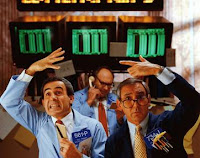“Never, Ever” Land

It’s an undisputed fact that the vast majority of retirement plan participants never rebalance their accounts. It’s one of the reasons that that initial investment decision, particularly in a default situation, is so crucial. And most of us would guess that those participants who do make changes probably make a mess of it.
However, new research from the Vanguard Center for Retirement Research tells a different story. Their report indicates that “traders” outperformed nontraders by 0.55% on an annualized basis.
Not that we should draw much comfort from that result. First, only 17% of the one million or so participants in the Vanguard sampling were “active” traders (averaging just a bit under three trades each, but most did only one)—and, according to the Vanguard researcher, on a risk-adjusted basis, these same traders fared no better than nontrading participants. In effect, the extra risk they took on—during the relatively mild investing climate of 2003 and 2004—wiped out the benefit of their trading (though, at the end of the day, I’m not sure participants are willing to undertake the statistical analysis to appreciate that impact).
Realign Mien?
The more interesting conclusions, IMHO, dealt not with trading, but with rebalancing; the realignment of the investment portfolios within a reasonably tight percentage of a target allocation—10 percentage points, in the Vanguard evaluation. This group Vanguard termed “active” rebalancers” because they took action to maintain an asset allocation. Another group, which Vanguard termed passive rebalancers, never traded on their own and invested their entire balance in a balanced fund or a lifestyle fund during the period. Their accounts were presumably rebalanced, but without their involvement or intervention.
Compared with nontraders, on a risk-adjusted basis, these passive rebalancers realized excess annual returns of 84 basis points. The active rebalancers didn’t fare quite as well—but still earned 26 basis points in excess risk-adjusted returns. So, at least on a risk-adjusted basis, rebalancers did better than nontraders—but only 6% of the research sampling were passive rebalancers, and only 3% were active rebalancers. In total, these rebalancers were just half the so-called “active” trader total of 17%. The remaining 72%, of course, were nontraders.
Not So Fast
The research results, while intriguing, must be considered with care. A lucky asset allocation, left unattended, could prove to be quite profitable in the long run. Meanwhile, a more balanced portfolio, rebalanced on a systematic basis, could well experience losses in the short-term that an undiversified portfolio during that same period might avoid. Still, the research would seem to support the notion that a well-diversified portfolio, regularly and professionally managed, can be prudent and profitable.
Moreover, these days, an “active” rebalancing program can frequently be put in place with the click of a button—a passive rebalancing program with the mere selection of an appropriate target-date offering. The challenge is to help move the remaining majority of participants—who never, ever touch their accounts—to a rebalancing model that can make a real difference in their retirement security.
- Nevin Adams
Note: Foregoing the scientific “risk-adjusted” statistical analysis for one participants are more likely to rely on — their side-by-side comparison of participant statements with their neighbor's —it was better to be active than passive, and better to be a nontrader than a passive rebalancer.
Active rebalancers enjoyed an annualized return of 18.86% during the period of study, outpacing the 16.90% of active traders, and the 16.77% of nontraders. Passive rebalancers were at the bottom, gaining just 15.25%. Now, that's not on a "risk-adjusted" basis - but it's real money.



Comments
Post a Comment